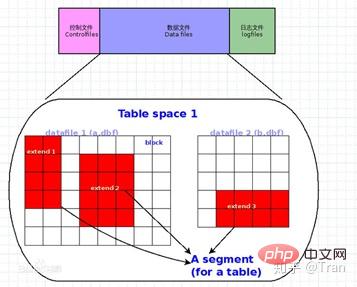What is oracle tablespace
Oracle table space is a logical division of the database and the smallest unit for Oracle database recovery. It accommodates many database entities, such as tables, views, indexes, clusters, rollback segments, temporary segments, etc. An Oracle database can have one or more table spaces, and a table space corresponds to one or more physical database files.

The operating environment of this tutorial: Windows 7 system, Oracle 11g version, Dell G3 computer.
1. Concept
Oracle tablespaces (tablespaces) is a logical concept. Data files are what actually store data. An Oracle database can have one or more table spaces, and a table space corresponds to one or more physical database files.
Table space is the smallest unit for Oracle database recovery, housing many database entities, such as tables, views, indexes, clusters, rollback segments, temporary segments, etc.
1. Features of Oracle table space:
(1) Control database data disk allocation;
(2) Restrict users in the table space The amount of disk space that can be used;
(3) The table space has online, offline, readonly, and readwrite attributes.
2. Classification of table spaces:
Permanent table space: some objects to be permanently stored in the database, such as: tables, views , Stored procedure
Temporary table space: The process executed in the middle of the database operation. After the execution is completed, the stored content will be automatically released
UNDO table space: used to save the old values of transaction modified data, and can roll back the data
Segment (segment) refers to the space occupied by the data file Common name, or a collection of space used by database objects; segments can include table segments, index segments, rollback segments, temporary segments, cache segments, etc.
Extent (Interval/Extension), any continuous block allocated to an object (such as a table) is called an interval; the interval is also called an extension, because when it uses up the allocated interval, it will When new records are inserted, a new interval must be allocated (that is, some blocks are extended); once the interval is allocated to an object (table, index, and cluster), the interval cannot be allocated to other objects.

Structural diagram

datafile, segment, extend relationship diagram
2. Related views
select * from dba_data_files; --describes database files 数据文件信息 select * from dba_temp_files; --describes all temporary files (tempfiles) in the database 临时数据文件信息 select * from dba_free_space; --describes the free extents in all tablespaces in the database 数据库中所有表空间中的空闲扩展区 select * from dba_segments; --describes the storage allocated for all segments in the database 数据库中的所有段分配的存储



3. Related operations
1. Create table space
--语法: create [temporary] tablespace tablespace_name tempfile|datafile ‘xx.dbf’ size xx; --创建临时表空间时,加上temporary关键字;
2. Expand the table space. When a certain table space is used up, the insert operation can no longer be performed on the database table. At this time, we need to expand the table space. , you can expand the table space by adding datafile files.
select f.* from dba_data_files f where f.tablespace_name='MLT';--查看表空间信息
alter tablespace MLT --表空间名
add datafile '/home/oracle/oradata/crm/mlt04.dbf' --datafile文件路径
size 100M --表空间大小
autoextend on --自动扩展
3. Modify the status of the table space
alter tablespace tablespace_name online|offline;--表空间是脱机时不可用,默认是联机的
4. Delete table space
drop tablespace tablespace_name[including contents]; --including contents 表示删除表空间包括datafile数据文件,不加则不删除相关数据文件; --删除数据文件时,不能删除表空间当中第一个数据文件,如果要删除就需要删除整个表空间。
5. Check table space usage
--查询表空间使用情况SELECT Upper(F.TABLESPACE_NAME) "表空间名",
D.TOT_GROOTTE_MB "表空间大小(M)",
D.TOT_GROOTTE_MB - F.TOTAL_BYTES "已使用空间(M)",
To_char(Round(( D.TOT_GROOTTE_MB - F.TOTAL_BYTES ) / D.TOT_GROOTTE_MB * 100, 2), '990.99')
|| '%' "使用比",
F.TOTAL_BYTES "空闲空间(M)",
F.MAX_BYTES "最大块(M)"FROM (SELECT TABLESPACE_NAME,
Round(Sum(BYTES) / ( 1024 * 1024 ), 2) TOTAL_BYTES,
Round(Max(BYTES) / ( 1024 * 1024 ), 2) MAX_BYTES
FROM SYS.DBA_FREE_SPACE
GROUP BY TABLESPACE_NAME) F,
(SELECT DD.TABLESPACE_NAME,
Round(Sum(DD.BYTES) / ( 1024 * 1024 ), 2) TOT_GROOTTE_MB
FROM SYS.DBA_DATA_FILES DD
GROUP BY DD.TABLESPACE_NAME) DWHERE D.TABLESPACE_NAME = F.TABLESPACE_NAME--查询表空间的空闲扩展区select tablespace_name, count(*) AS extends,round(sum(bytes) / 1024 / 1024, 2) AS 大小/MB,sum(blocks) AS blocks from dba_free_space group BY tablespace_name;--查询表空间的总容量select tablespace_name, sum(bytes) / 1024 / 1024 as MB from dba_data_files group by tablespace_name;--查询表空间使用率SELECT total.tablespace_name,
Round(total.MB, 2) AS 总量/MB,
Round(total.MB - free.MB, 2) AS 已使用/MB,
Round(( 1 - free.MB / total.MB ) * 100, 2) || '%' AS 使用率FROM (SELECT tablespace_name,
Sum(bytes) / 1024 / 1024 AS MB
FROM dba_free_space
GROUP BY tablespace_name) free,
(SELECT tablespace_name,
Sum(bytes) / 1024 / 1024 AS MB
FROM dba_data_files
GROUP BY tablespace_name) totalWHERE free.tablespace_name = total.tablespace_name;Recommended tutorial: "Oracle Tutorial》
The above is the detailed content of What is oracle tablespace. For more information, please follow other related articles on the PHP Chinese website!

Hot AI Tools

Undresser.AI Undress
AI-powered app for creating realistic nude photos

AI Clothes Remover
Online AI tool for removing clothes from photos.

Undress AI Tool
Undress images for free

Clothoff.io
AI clothes remover

Video Face Swap
Swap faces in any video effortlessly with our completely free AI face swap tool!

Hot Article

Hot Tools

Notepad++7.3.1
Easy-to-use and free code editor

SublimeText3 Chinese version
Chinese version, very easy to use

Zend Studio 13.0.1
Powerful PHP integrated development environment

Dreamweaver CS6
Visual web development tools

SublimeText3 Mac version
God-level code editing software (SublimeText3)

Hot Topics
 1669
1669
 14
14
 1428
1428
 52
52
 1329
1329
 25
25
 1273
1273
 29
29
 1256
1256
 24
24
 What to do if the oracle can't be opened
Apr 11, 2025 pm 10:06 PM
What to do if the oracle can't be opened
Apr 11, 2025 pm 10:06 PM
Solutions to Oracle cannot be opened include: 1. Start the database service; 2. Start the listener; 3. Check port conflicts; 4. Set environment variables correctly; 5. Make sure the firewall or antivirus software does not block the connection; 6. Check whether the server is closed; 7. Use RMAN to recover corrupt files; 8. Check whether the TNS service name is correct; 9. Check network connection; 10. Reinstall Oracle software.
 How to solve the problem of closing oracle cursor
Apr 11, 2025 pm 10:18 PM
How to solve the problem of closing oracle cursor
Apr 11, 2025 pm 10:18 PM
The method to solve the Oracle cursor closure problem includes: explicitly closing the cursor using the CLOSE statement. Declare the cursor in the FOR UPDATE clause so that it automatically closes after the scope is ended. Declare the cursor in the USING clause so that it automatically closes when the associated PL/SQL variable is closed. Use exception handling to ensure that the cursor is closed in any exception situation. Use the connection pool to automatically close the cursor. Disable automatic submission and delay cursor closing.
 How to create cursors in oracle loop
Apr 12, 2025 am 06:18 AM
How to create cursors in oracle loop
Apr 12, 2025 am 06:18 AM
In Oracle, the FOR LOOP loop can create cursors dynamically. The steps are: 1. Define the cursor type; 2. Create the loop; 3. Create the cursor dynamically; 4. Execute the cursor; 5. Close the cursor. Example: A cursor can be created cycle-by-circuit to display the names and salaries of the top 10 employees.
 How to export oracle view
Apr 12, 2025 am 06:15 AM
How to export oracle view
Apr 12, 2025 am 06:15 AM
Oracle views can be exported through the EXP utility: Log in to the Oracle database. Start the EXP utility, specifying the view name and export directory. Enter export parameters, including target mode, file format, and tablespace. Start exporting. Verify the export using the impdp utility.
 What to do if the oracle log is full
Apr 12, 2025 am 06:09 AM
What to do if the oracle log is full
Apr 12, 2025 am 06:09 AM
When Oracle log files are full, the following solutions can be adopted: 1) Clean old log files; 2) Increase the log file size; 3) Increase the log file group; 4) Set up automatic log management; 5) Reinitialize the database. Before implementing any solution, it is recommended to back up the database to prevent data loss.
 Oracle's Role in the Business World
Apr 23, 2025 am 12:01 AM
Oracle's Role in the Business World
Apr 23, 2025 am 12:01 AM
Oracle is not only a database company, but also a leader in cloud computing and ERP systems. 1. Oracle provides comprehensive solutions from database to cloud services and ERP systems. 2. OracleCloud challenges AWS and Azure, providing IaaS, PaaS and SaaS services. 3. Oracle's ERP systems such as E-BusinessSuite and FusionApplications help enterprises optimize operations.
 What steps are required to configure CentOS in HDFS
Apr 14, 2025 pm 06:42 PM
What steps are required to configure CentOS in HDFS
Apr 14, 2025 pm 06:42 PM
Building a Hadoop Distributed File System (HDFS) on a CentOS system requires multiple steps. This article provides a brief configuration guide. 1. Prepare to install JDK in the early stage: Install JavaDevelopmentKit (JDK) on all nodes, and the version must be compatible with Hadoop. The installation package can be downloaded from the Oracle official website. Environment variable configuration: Edit /etc/profile file, set Java and Hadoop environment variables, so that the system can find the installation path of JDK and Hadoop. 2. Security configuration: SSH password-free login to generate SSH key: Use the ssh-keygen command on each node
 How to stop oracle database
Apr 12, 2025 am 06:12 AM
How to stop oracle database
Apr 12, 2025 am 06:12 AM
To stop an Oracle database, perform the following steps: 1. Connect to the database; 2. Shutdown immediately; 3. Shutdown abort completely.




